Zigzag failure: automatic revolver "Vebley-Fosbury" and others with it
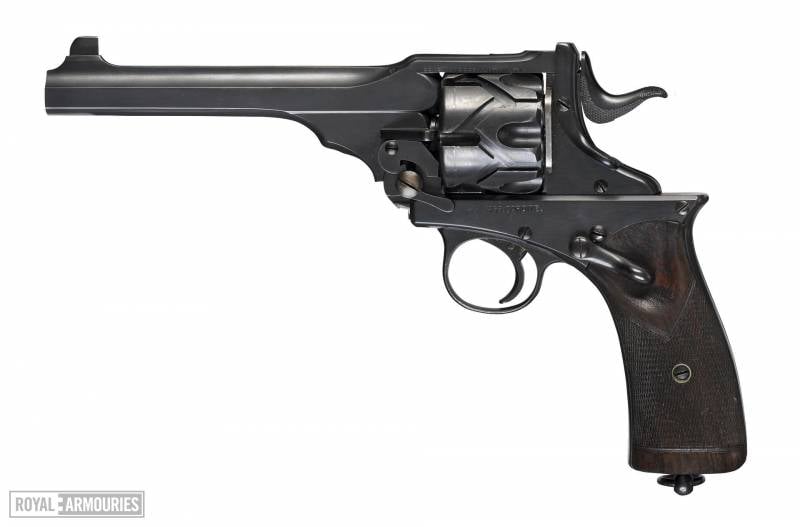
The six-shot Webley-Fosbury revolver of .455 model 1901 and the same year of manufacture. Royal Arsenal, Leeds, UK
gathered two hundred farmers from the bay,
armed with shotguns and sporting rifles,
and a ridiculously small number of automatic revolvers,
and led them to set fire to the minuteman barracks. "
“It's Impossible With Us,” Sinclair Lewis
History firearms weapons. The appearance of this material was preceded by two circumstances at once: first, a request from one of the readers of the article about the Mauser revolver to write about other samples of weapons, the same revolvers that had “zigzag” grooves on the drum.
The second is related to the memory of the books read.
There are a number of books (in particular, Sinclair Lewis's famous admonition novel "It's impossible with us") that feature automatic revolvers.
And here the main question arises: were they?
Did they exist in reality, or was this the mistake of an idle novelist?
The last question is the easiest to answer. Yes, automatic revolvers did exist. This is not a fiction.
But what kind of revolvers they were, and how did their automation work? We will talk about this today.
This unusual weapon, combining the qualities (good and bad) of both a revolver and a self-loading pistol, was the brainchild of British Colonel G. W. Fosbury.
He received a patent for his revolver on August 16, 1895, and then, having slightly modified its design, patented it again in June and October 1896.
That is, this revolver is the same age as the famous Mauser pistol and, obviously, then a number of designers were trying to find an opportunity to automate the work of both pistols and revolvers.
Fosbury did not have to look for a manufacturer for a long time: when he turned to Vebley and Son in Birmingham, they listened to him there with great attention. A year later, the company changed its name, and already in July 1900, the serial production of the Vincent Fosbury revolver began, which received the following name: "Vebley-Fosbury automatic revolver".
It was produced for a relatively long time, until 1918, and during this period about 4 copies of these revolvers were produced. However, this revolver was never in service with the British army, since it had one intractable defect: in the event of a cartridge misfire, it was impossible to manually crank the revolver drum.
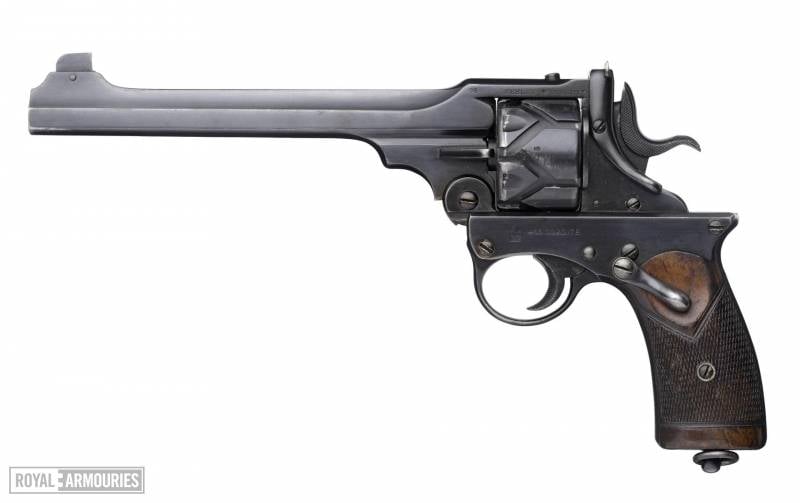
Model 1914 The sport version of the revolver, with a barrel length of 190 mm, had an even softer trigger and even more precise automatic control. Its shooting accuracy was simply unattainable for other self-cocking revolvers, since a significant effort was spent on turning the drum in not only one index finger, but also the entire hand. Therefore, the shooters-sportsmen loved him very much. However, due to its obvious superiority over other service models, its use was recognized as "not sporting", and was banned in 1918, driving the very last nail into the coffin of even such a success! Royal Arsenal, Leeds, UK
The revolvers were chambered for .455 and .38 calibers (six and eight-shot, respectively) and with barrels of different lengths: 190 mm and 152 mm, but there was also a model with a barrel length of only 100 mm.
Despite the fact that they were not accepted into service, many British officers acquired them privately. So they smelled gunpowder both during the Boer War and during the First World War, where, in addition to officers, they tried to arm observer pilots of British airplanes.
Be that as it may, this revolver was the first revolver in which, for reloading, the recoil force generated by each successive shot was used both to rotate the cylinder and, at the same time, to cocking the trigger for the next shot. That is, when firing self-cocking, the shooter did not have to forcefully press the trigger in order to simultaneously turn the revolver drum and cock its hammer.
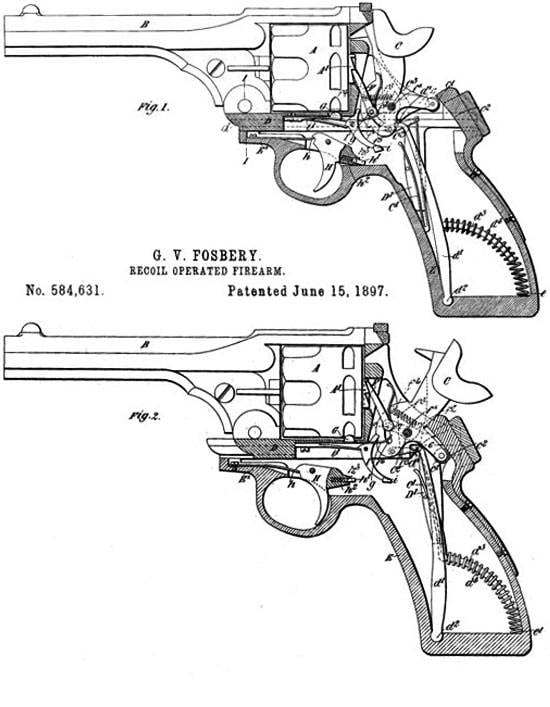
Diagram of a revolver from a US patent issued to Colonel Fosbury for his automatic revolver:
Fig. 1 - The upper part of the revolver frame is in its original position before firing.
Fig.2 - The upper part of the frame moves back under the influence of recoil, while it cocks the trigger and turns the drum.
This was achieved due to the fact that the frame of this revolver was designed in two parts.
The lower one consisted of a handle with a trigger, a spring and guides on its upper part.
The upper part of the frame - consisted of a barrel and a drum, and it could slide along the guides of the lower part, but was held in place by a spring.
When recoil, a special pin, fixed on the lower frame, followed the zigzag grooves on the drum and turned it so that the next charged chamber stood opposite the barrel. At the same moment the hammer is cocked.
When all the ammunition in the drum was used up, the revolver could be reloaded by pressing the barrel lock and turning the barrel downward on the hinge, thus pivoting the rear of the drum up. At the same time, the automatic extractor immediately pulled out empty sleeves from the drum chambers.
That is, it was a system similar to all other Webley revolvers and Smith and Wesson revolvers.
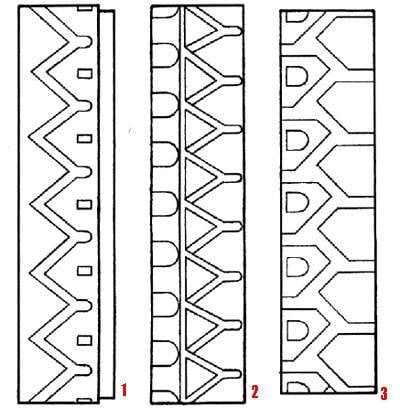
Types of guiding zigzag grooves of the drum
revolvers of different years of release:
1 - "Webley-Fosbury" M 1901 caliber .455,
2 - "Webley-Fosbury" M 1901 caliber .38,
3 - "Vebley-Fosbury" M 1902 and "Vebley-Fosbury" M 1914
The cartridges could be inserted into the drum either one by one, or all at once, using a flat steel clip, after which the barrel was lifted and locked. After that, the revolver could shoot after pressing the trigger, and for the first shot the hammer was cocked manually. But then it was enough to press the trigger, without putting any special efforts on it, so that the shots from it followed one after the other.
Revolvers "Vebley-Fosbury" also had a manual safety lever located on the left side of the handle.
In fact, this revolver did not have too many advantages over modern revolvers of the same caliber.
Basically, the advantages were less recoil (due to the fact that, firstly, it was absorbed by the spring, and secondly, because of its greater weight - 1,23 kg) and improved accuracy during automatic shooting, which in conventional self-cocking revolvers was unattainable.
However, the mechanism was quite sensitive to dirt and especially suffered from sand getting into it. And its reloading was carried out not much faster than that of modern revolvers, despite the fact that special flat clips were developed for this weapon, which simultaneously accommodate six cartridges of .455 caliber or eight - .38.
The proverb states that "bad ideas are contagious", although it cannot be fully applied to the above-mentioned revolver.
But nevertheless, he did not enjoy massive success.
And nevertheless, there were imitators of this design. And not anywhere, but overseas, in the USA, where in 1909 the designer Charles Lefebvre - one of the sons of the founder and owner of the American Lefebvre Armory Company, Daniel Lefebvre, known for his invention of a hammerless gun, created the Union revolver, as two peas in a pod similar to Vebley-Fosbury.
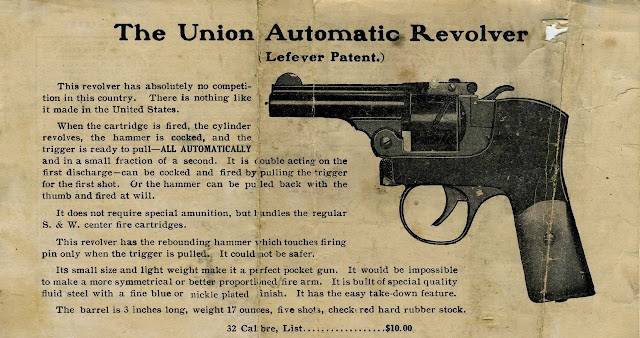
Advertising revolver "Union"
However, in some ways he still differed from him.
First of all, in size - it was much smaller both in size and in its caliber: it fired .38 "Smith and Wesson" cartridges.
He received an American patent for it and was able to organize its mass production at his father's company.
The revolver cost $ 10, which is not so little for such a "kid" who, among other things, looked unremarkable.
It acted in exactly the same way as "Smith and Wesson" (unloading) and like "Vebley-Fosbury" (automatic), but it was simpler, and also had a box in the back, into which the movable upper part of the frame rolled back. In this he was more comfortable than a British revolver.
Nevertheless, he did not enjoy much success in the market. It was released for only three years, after which its production was stopped.
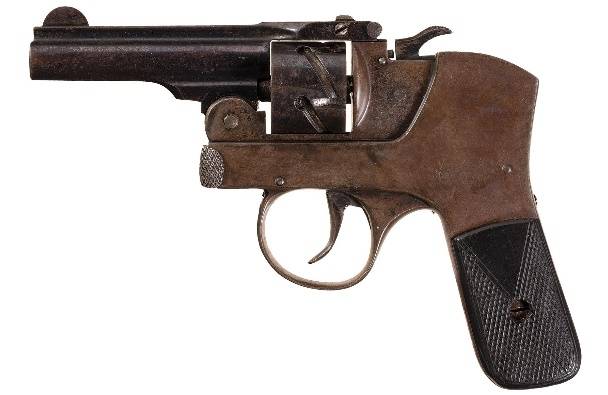
The appearance of the revolver "Union"
All these are classic revolvers, albeit with an automatic drum and trigger drive.
However, a man was found - his name was Halvard Landstad, who created an automatic revolver patented in Norway in 1899 (Norwegian patent 8564, April 11, 1899), which was, in fact, not so much a revolver as a pistol (magazine in the handle). But at the same time, all the same, and a revolver (the drum and the presence of a cartridge in it at the time of the shot).
That is, Landstad managed to "cross a snake and a hedgehog" quite well and get a completely workable design.
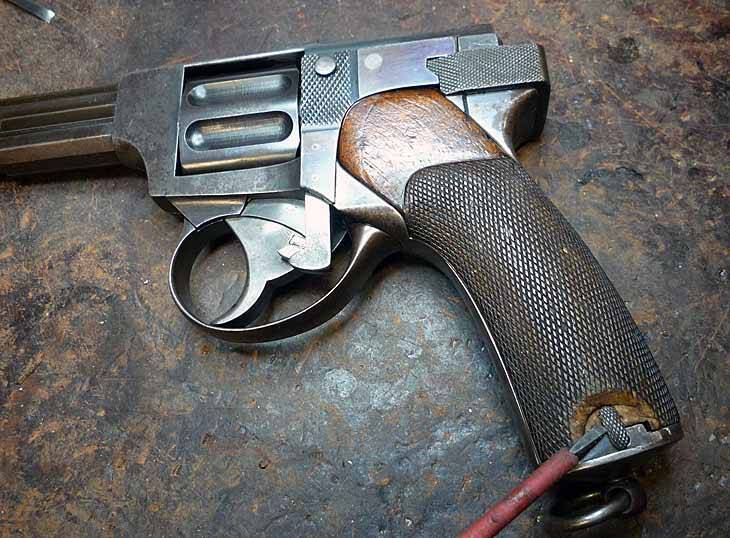
The appearance of the Landstad revolver. Pay attention to the drum pusher connected to the trigger: when the hook retreated, it pressed on this pusher, it went up, turned the drum and at the same time, at the very end, pulled the trigger from the combat platoon!
Its drum had only two chambers - upper and lower, and was a "flat box". The longitudinally sliding bolt sent the cartridge from the box magazine in the handle to the lower chamber, and then, when the trigger was pressed, the drum turned 180 °, and a shot from the upper chamber was fired. Then the shutter, under the influence of the recoil force, moved back, ejected the empty sleeve from the upper chamber and simultaneously charged the lower one.
Thus, unlike other systems, this weapon automatically performed a full loading cycle, including the extraction of the cartridge case.
The Landstad revolver was tested in Norway, but never entered service.
The magazine was small: only six cartridges 7,5x23R, and besides, it was inserted not from below, but from the side on the left, which was completely inconvenient. There was no fuse on it, but due to the long trigger travel, it was unlikely. A shot could not have occurred when this revolver-pistol fell on a hard floor, since there was never a cartridge in the upper chamber opposite the barrel. He got there only at the moment of the shot, and because of the flat shape of the drum, he could not turn. But this is where all his merits ended!

The drum turns, the bolt striker moves back ...
Today there are also automatic revolvers of a rather interesting design. And not only do they exist: they are produced and bought. But we will tell about them some other time.
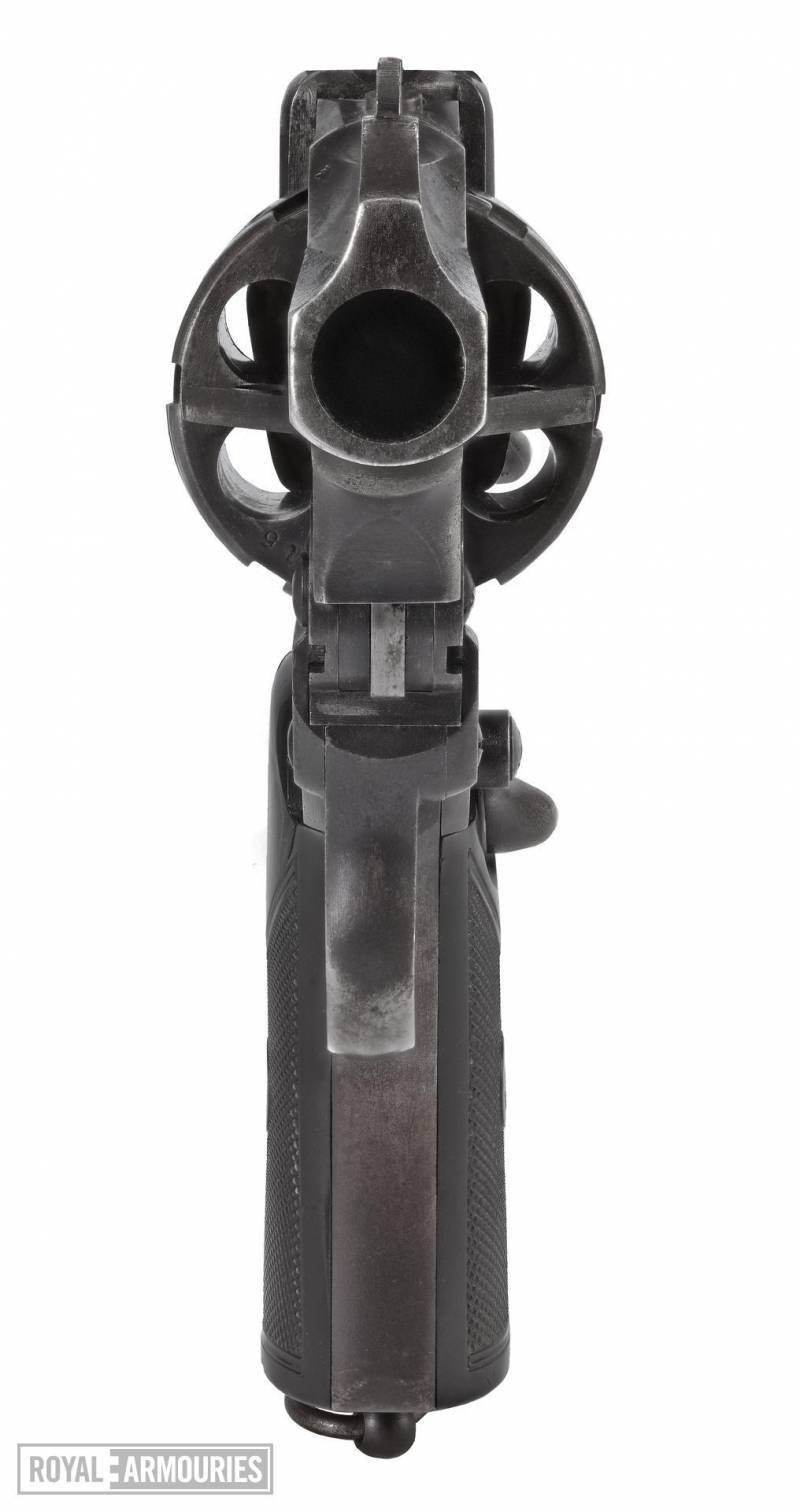
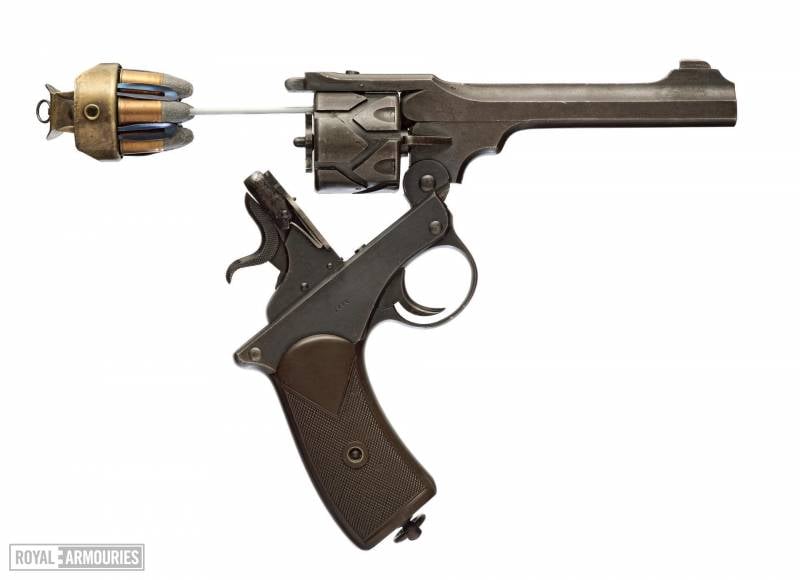
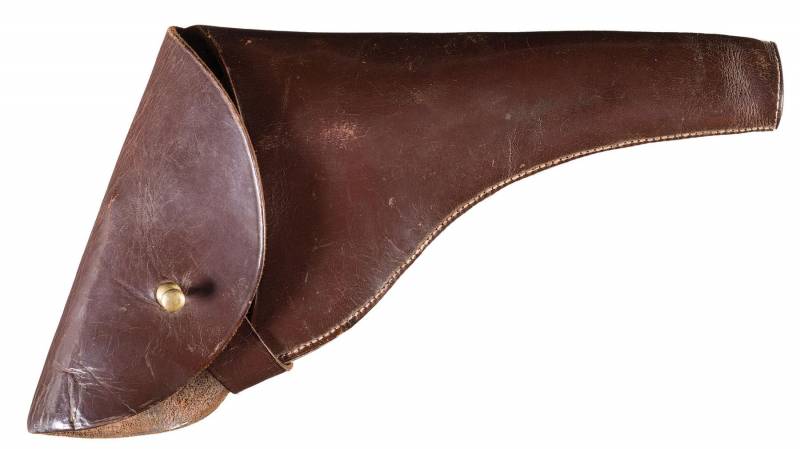
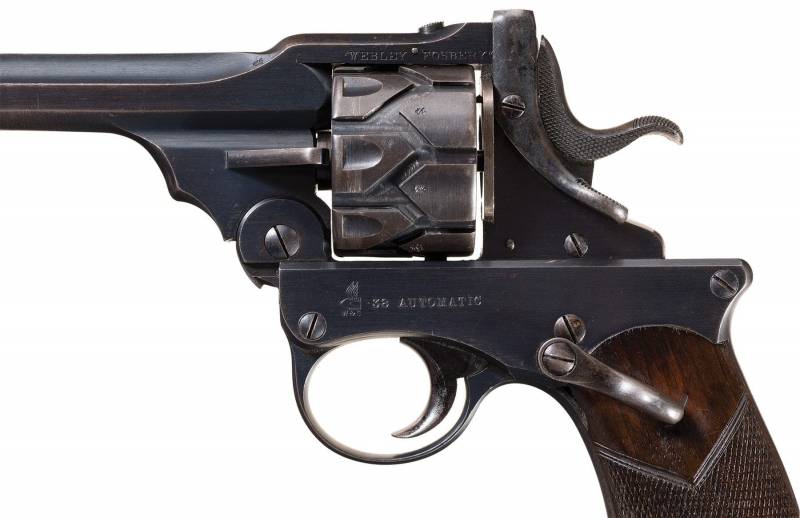
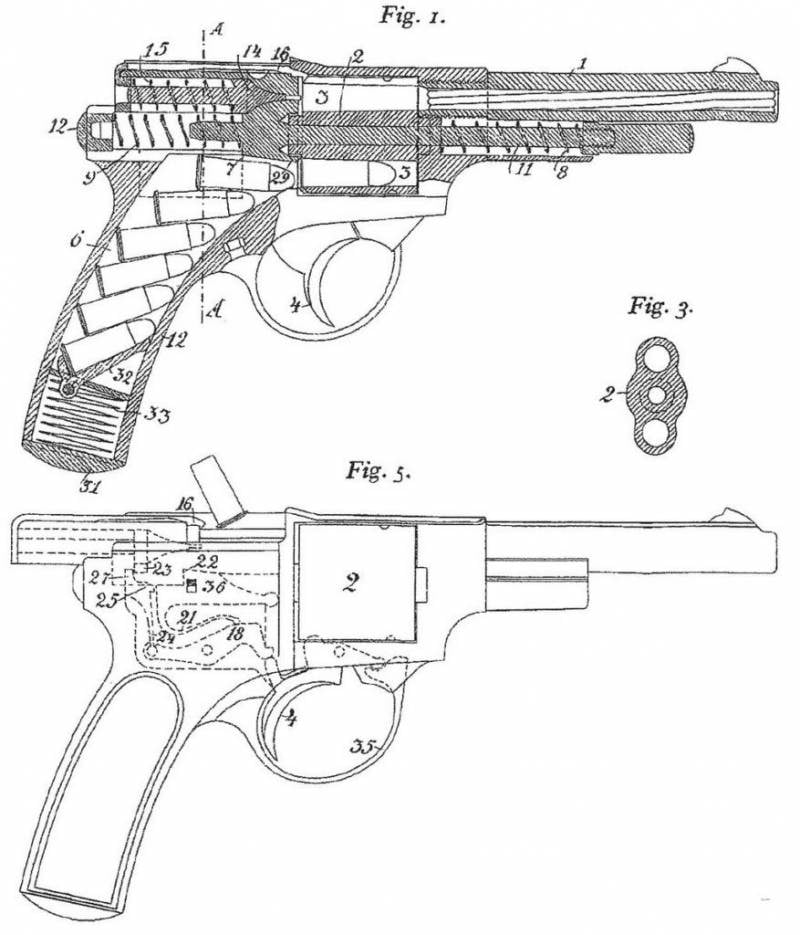
Information